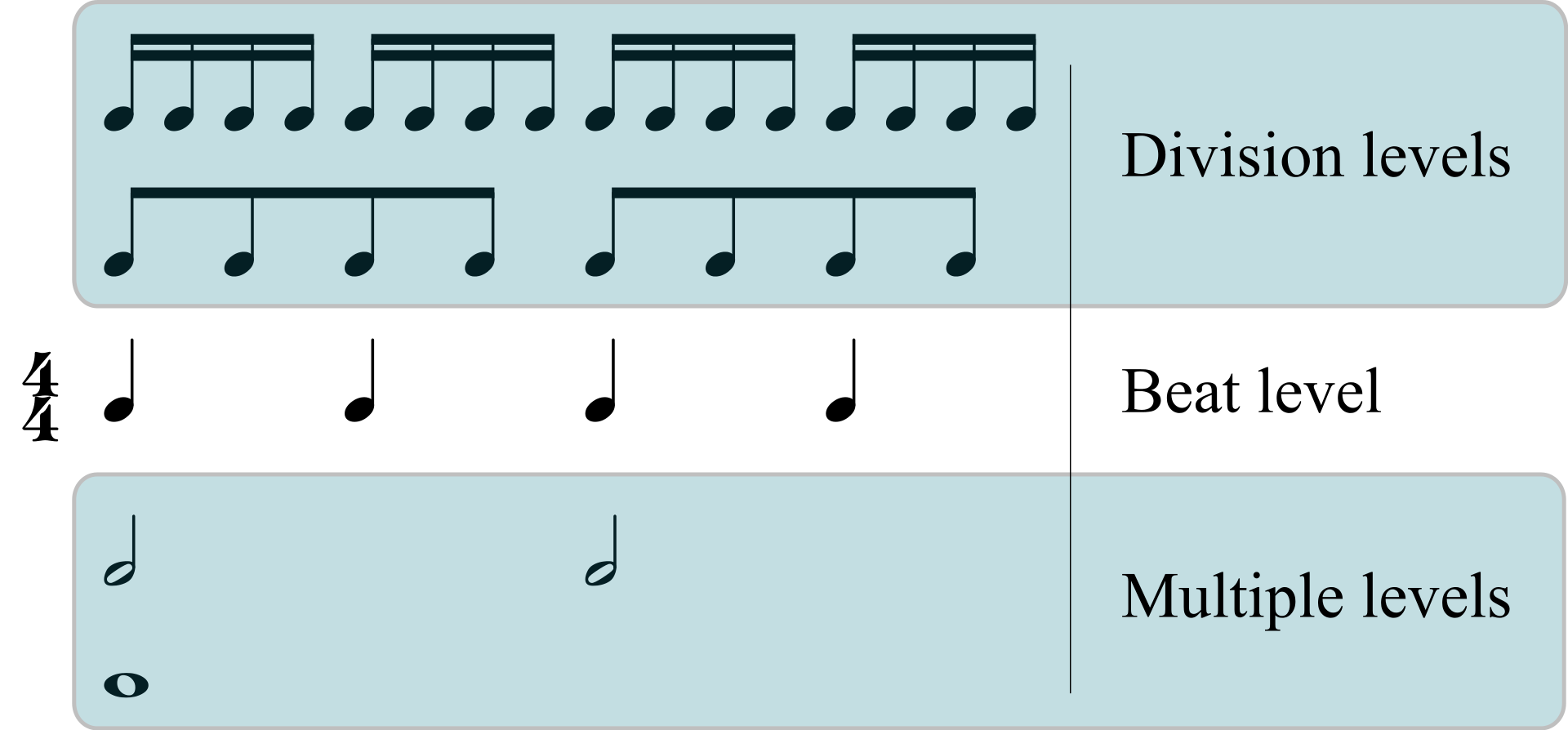There is no "official" list of rhythmic rudiments for non-percussion instruments,1 but such a list can be inferred by the way rhythm is introduced in various training methods and certificate exams. I give a loosely graded list of rudiments first, with the sources following.2
1 I propose that one reason for this is that in percussion training there is a tighter correlation between rhythm and technique; whereas for other instruments, rhythm is more tightly correlated with sight-reading.
2 "Loosely graded", because, as can be seen from the source, there is variation, sometimes substantial, in how different authors/organizations choose to introduce rhythmic and metrical concepts.
Rhythmic rudiments
I borrow the following language from Richard Hoffman (see Sources, below):
First division: half beats (e.g., eighth notes in 4/4 time) and 1/3 beats (e.g., eighth notes in 6/8 time)
Second division: first division divided by half (e.g., sixteenth notes in 4/4 or 6/8 time)
- Whole-beat and first division notations in simple meter
A. 1-, 2-, and 4-beat notations
B. Add 3-beat notations and rests
C. Add anacruses ("pickup" beats)
- Whole-beat and first division notations in compound meter
- Dotted whole beats (i.e., 1.5 beats), ties, simple syncopations
- Second division, including dotted rhythms
- Triplets
- Three against two
- Changing meters
- Irregular divisions of the beat (five-tuplets, seven-tuplets)
- Four against three
- Irregular meters (5/4, 7/8)
- Polymeter, cross-rhythm, non-metric measures
Sources
Richard Hoffman, The Rhythm Book, 2nd edition (Smith Creek Music, 2009)
- Simple meter, whole beats plus first division (half-beats)
- Pickup beats
- Second division (including dotted rhythm)
- Dotted and tied whole and first division rhythms
- Compound meter (beat = dotted quarter; including dotted rhythm and second division)
- Compound meter with ties (introduce hypermeter)
- Multiple dots, complex ties, third division
- Syncopation and hemiola
- Duplets and triplets
- Two against three
- Meter changes (regrouping)
- Meter changes (constant beat)
- Meter changes (constant division)
- Superduplets -triplets
- Irregular divisions (5, 7)
- 4:3
- Asymmetric meter (5, 7)
- Polymeter, cross-rhythm, non-metric rhythm
- Early and contemporary music
Anne Carothers Hall, Studying Rhythm, 3rd edition (Pearson Prentice Hall, 2005)
- Simple meters including half-beat (first division)
- Dotted/ties rhythms (simple meter)
- Compound meter
- Second division (simple meter)
- Dotted rhythm requiring second division (simple meter)
- Second division (compound meter)
- Simple meter syncopation
- Compound meter syncopation
- More compound meter (9, 12)
- Triplets
- 3:2
- Cut time ("half-note beat")
- Dotted-half beat
- Eighth note beat
- Dotted-eighth beat
- Further subdivisions
- Metric changes (simple meters)
- Metric changes (compound meters)
- Metric changes (constant division)
- Metric changes (constant beat)
- Superduplets -triplets
- 4:3
- Irregular divisions
- Irregular meter
- Other meters
- Changing meters with unequal beats
- Cross-rhythms
- Metric modulation
Robert Starer, Rhythmic Training (MCA Music Publishing, 1969)
- whole beats, simple meter
- first division
- compound meter
- second division
- mixing divisions
- other beat divisions
- metric change (constant division)
- polyrhythm
Washington State Music Teachers Association Music Literacy Program
- Level 1: whole beats in simple meter
- Level 2: whole beats in simple meter with dotted half and rests
- Level 3: first division and ties
- Level 4: upbeats, dotted quarter
- Level 5: triplets
- Level 6: second division, compound meter
- Level 7: two handed -- pulse in one hand
- Level 8: rhythms in both hands, count aloud
- Level 9: same (no counting)
- Level 10: 3:2
ABRSM Piano 2021-2022 (Sight reading)
- Initial: whole beats, simple meter, first division
- Grade 1: add dotted half, more rests
- Grade 2: add dotted quarter
- Grade 3: second division, dotted eighth, compound meter
- Grade 4: upbeats (anacrusis)
- Grade 5: syncopation (simple)
- Grade 6: triplets, irregular meter (5)
- Grade 7: irregular meter (7)
- Grade 8: add 12/8



